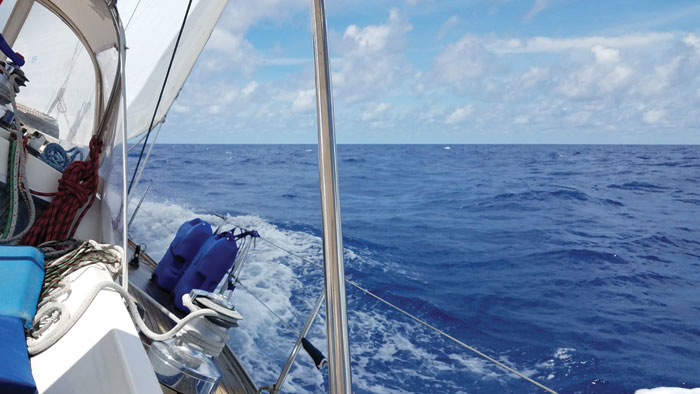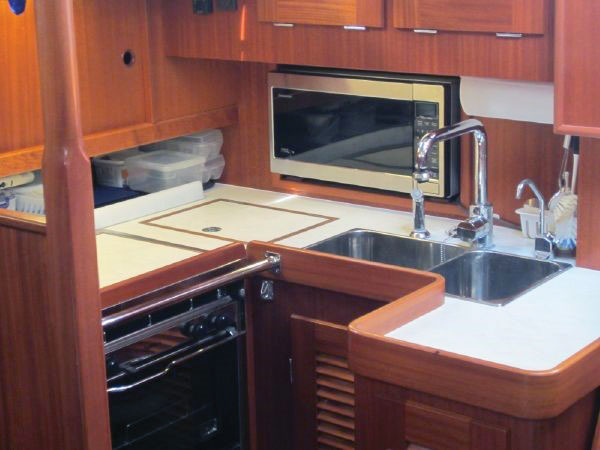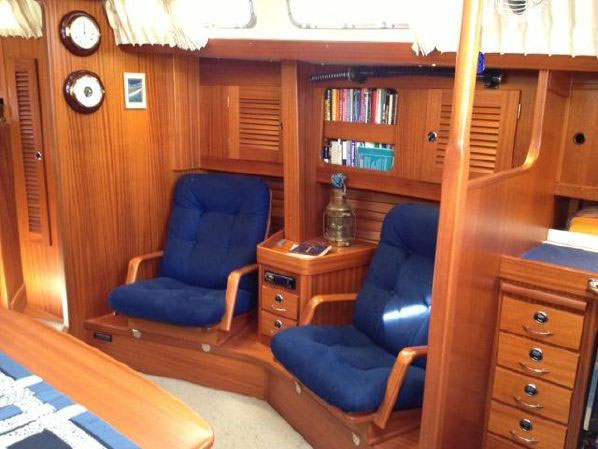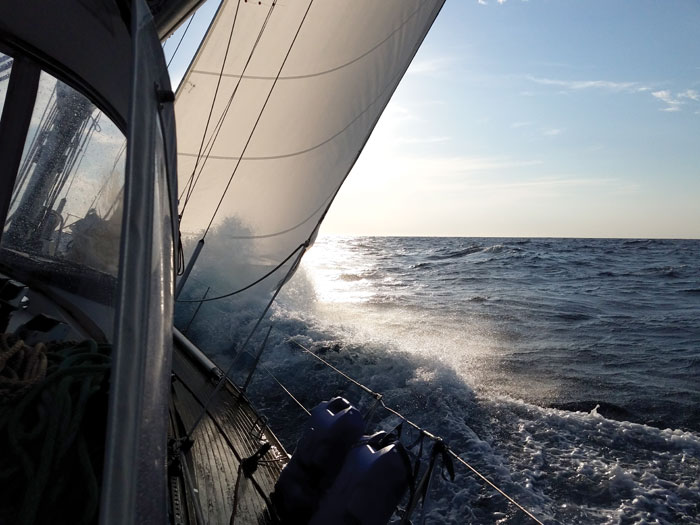A plan to go cruising in five years
There is a reason it is said that you must cut your shore line rather than simply releasing it to be able to go cruising full time. The life forces that tie us to shore life are formidable and complex and cannot be simply untied like releasing a dock line from a dock cleat. That is why the saying is that one must cut their shore line to be free to leave shore life behind and go cruising full time to distant shores.

Many have of us have been nurturing a cruising dream for years if not decades. However, translating this particular dream with actions to help make it become a reality is much harder than one would expect. It will require tenacity and determination to keep focused on the ultimate goal. It will ask for deep levels of faith that the effort is worth the rewards once achieved. Most of all it will need a good practical action plan.
Some adventurous free spirits out there (foolhardy to some of us) will leap into this with abandon and simply leave everything in their onshore life behind and just go cruising. They have documented their incredible adventures and transition in the many YouTube cruising channels. For most of us that is realistically not possible or advisable. So, what are we to do then? Is there a practical plan with clear steps that can lead to sailing away at sunset toward distant horizons?
I can confidently share that yes, there is. Here is the plan we have executed over a period of five years. Our plan culminated with our joining the Salty Dawgs Fall Rally from Hampton to Antigua in November to start full-time cruising.
The most critical pre-plan step needed is sorting out your realistic finances. You need to figure out what you can afford for purchase of a good cruising boat, fit-out and upgrade costs, and lastly your steady cash flow stream for cruising monthly costs. The realistic monthly cost for cruising full time ranges from$1000 to $4000 per month. This range is confirmed by the many actively cruising boats. The range covers modest to extravagant life choices with $2000 as a good midpoint target per month.
Start with a sound analysis of your finances and calculate a reasonable budget you can afford to spend on a good cruising boat. The purchase cost of the boat should also include the 25 percent for needed fit-out/upgrades and is part of the boat budget assuming the boat is in good shape when purchased without any major system repairs.
After the realistic purchase number has been determined and the fit-out/upgrade budget estimated, the plan can be put into action.

Step 1: Search for and purchase a good boat
This step should take some time. Too many inexperienced sailors rush into the buying decision and select boats for the wrong reasons and needs. Boat buying is an emotional decision that must be tempered with sound knowledge and sea miles of experience. If you happen to be a well-seasoned sailboat owner with decades of boat ownership experience, then you already know what you need, want, and like. You also probably have a short list of three to five boat brands that you would pick without hesitation and go to sea with.
For the average sailor looking for their first bluewater boat, this step cannot be hurried nor short changed. There are many advantages in seeing as many different cruising boats in person. Only you can judge if the cockpit will fit you and your needs, if the galley will work as your everyday liveaboard kitchen, if the head and shower will work for the both of you, if the salon will be your family living space. Storage size and engine room access and so many other small details about boats that need to be seen, experienced, and touched before one can begin to articulate what they are willing to live with and what they are not willing to live without. This enlightened wisdom can only come from time in and around boats with sea miles.
One sure method to accelerate the knowledge and learning process is to look for any opportunity to be in a place where cruising fleets gather. The Caribbean 1500 Rally and the Salty Dawn Rally, for example, gather in Hampton, VA, in early November and would be a perfect setting for Bay sailors. Taking time to mingle with many fellow cruisers will provide many opportunities to see and talk to them. Asking these owners about what they like and what they would change on their current good boats will provide for multitudes of lively conversations. The other advantage in being in such a setting is learning about what gear to consider for your own type of cruising.
The end of step one will be creating a short list of possible boats that can meet your needs. Then step one will be complete with the successful search for and purchase of a good cruising boat within your realistic budget.

Step 2: The fit-out upgrade period
It is important not to lose patience and rush through the fit-out/upgrade period. We are tempted to hurry and finish so we can enjoy our boats. Careful thought needs to be given for each system and component.
Let’s take one example. Let us say that the electronics on the boat are from 2005. Having new electronics that are networked and use modern touchscreen interface would be very desirable and convenient. However, it is not just replacing a few instruments that have to be considered in this case. The radar and chartplotter have to also be replaced since they are also obsolete and would not work with new generation instruments. In fact it will be the entire suite of electronic instruments at a total cost of $12 to $15K that will be needed for this upgrade.
Is this really the best use of the fit-out budget? The instruments are currently functional even though outdated and obsolete. A wiser approach perhaps is thinking through about adding AIS capabilities to current system. Another worthwhile addition in my mind is a new large cell-iPad as backup navigation platform with full GPS receiver. Perhaps spending on an Iridium GO for ship communication offshore and weather downloads is more important than having the shiny fancy electronics?
During this step of the plan, a slow methodical approach is best. Take each boat component and access its current condition and functionality. Then, decide if it is suitable for your needs as is. If it is not suitable, research what is available that will meet your needs. If the upgrade is affordable, proceed with that project until complete.
If you are realistic with yourself, you must allow the fit-out and upgrade period to take up to three years when done meticulously. This is also time needed to perform many of the tasks yourself and save a considerable amount of your budget for professional labor. If professional help is needed for specific steps outside your skill set, you can control the cost by performing the boat take apart yourself. When the marine professional arrives, they are to only perform the one specific task you agreed upon such as connecting and testing the black box. You are responsible for finishing the job and restoring the boat again after the professional has left.
As the boat transitions from fit-out project boat to functioning cruising boat, plan for extended weekend and weeklong shakedown trips. These are field trials of the boat and systems as well as pleasurable enjoyment of your hard labor. There is no substitute to using the boat to confirm if she is setup adequately for your everyday cruising use and needs. Other projects will present themselves as a result of these planned mini shakedown mini cruises.

Step 3: Sell the house and let go of the furniture
Warning: this step is very emotional. You cannot proceed until both of you are ready for it. Letting go of your home and all the lovely life belongings surrounding you is not for the timid of heart. If you are ready to downsize and simplify your life by starting this next phase, this is the time to do this step. Your goal is to move everything you really need with you onboard. Anything else worth keeping should fit a small storage unit. The rest is simply stuff that is not needed for the new cruising life. Having a natural disposition toward tiny homes is very helpful here. Think small and be ruthless about how many mixing bowls do you really need in the galley?
It will take several cycles of a purging process to condense your keepsakes down to the absolute essentials. The first year we moved aboard fulltime we had a 10- by 30-foot storage unit firmly believing that everything was essential. The following year we shrunk that storage unit to a 10- by 20-foot unit. Last year we reduced it down again to a 10- by 10-foot. Our goal now is to get to a 10- by eight-foot or smaller storage unit for our keepsakes.
During this step of the plan you will also experience your boat as a full-time liveaboard. The valuable lessons that will be learned are what will help you while cruising going forward. You will learn about where to stow things. You will come to understand that stowage on a boat is a never-ending process that evolves over time. You will discover what you carry onboard will change as you use things day in and day out. When you find something onboard that has not been used in one year and you never think about it, it needs to be removed from the boat. It is not needed period. Being able to transform your liveaboard boat from houseboat to cruising boat in 30 minutes is a lesson in ship-shape seamanship. These hands-on experiences will add to your boat skills and help with the transition to full time cruising. At the end of this step you will realize that you have become a cruiser that is in an extended stay at this port.

Step 4: Start limited cruising adventures
With the boat upgrade and fit-out projects nearing completion it will be time to test and enjoy the boat with voyages to some nearby distant shores. We are very fortunate to live in the Chesapeake Bay. A cruise to Norfolk can last four days to a week. A voyage to York River with exploration of Yorktown is a good week trip. Exploring the Chester River can be a week-long cruise.
When it is time for bluewater, then Annapolis to Block Island is a good distention cruise. Similarly, a trip to New York, Newport, or Martha’s Vineyard are all one-week to two-week adventures. Longer distance plans can include Camden, Portland, and Mount Desert Island, ME. Even more ambitious would be Nova Scotia as your first foreign port of call. Bermuda is another very convenient voyage for the Bay cruisers. This is a first taste of being out in the big blue away from any sight of land. This voyage needs a minimum of three weeks, if not four. You will learn so much about seamanship and boat handling. You will discover the true nature of your boat. You will quickly learn what works well and what needs more thought onboard.

Step 5: Cut the dock lines
Congratulations for arriving at this last step of the plan. Joining one of the many organized rallies from the East Coast to the Caribbean will help you complete the transformation to full time cruising. The rallies are particularly good at helping with safety gear knowledge, route planning, and weather planning. The friendships and comradery that will be forged during the prep week of the rally will last a lifetime. You have been preparing for this moment for some time now. When the day comes to vacate your liveaboard slip, symbolically cut one of the slip mooring lines. Leaving behind short snub of cut mooring line is declaring to the sea your intention to venture off to distant shores. May you have favorable wind and gentle following seas.
By Bassam Hammoudeh




